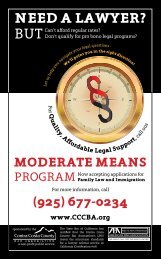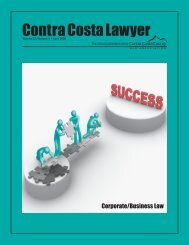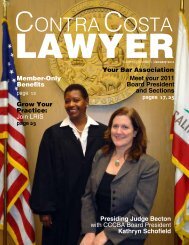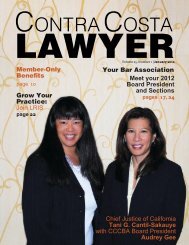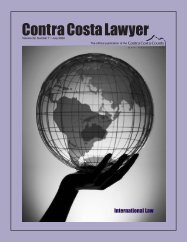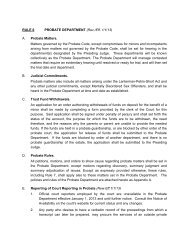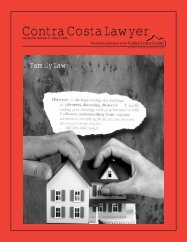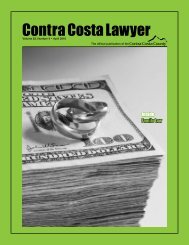Alternative Dispute Resolution Issue - Contra Costa County Bar ...
Alternative Dispute Resolution Issue - Contra Costa County Bar ...
Alternative Dispute Resolution Issue - Contra Costa County Bar ...
You also want an ePaper? Increase the reach of your titles
YUMPU automatically turns print PDFs into web optimized ePapers that Google loves.
Glenn & Dawson LLPCertified Public AccountantsDonald A. GlennCPA, ABV, CVA, CFE, CFFLeslie O. DawsonCPA, ABV, CVA, CFFSpecializing inLitigation Support – family lawBusiness ValuationsProbate and EstatesFinancial InvestigationsAudit Tax and Accounting Servicesfor individuals andprivately owned companies.323 Lennon Lane, First FloorWalnut Creek, CA 94598Telephone (925) 945-7722Facsimile (925) 932-1491Mark V. MurphyPersonal InjuryReferrals RequestedOver 25 years experiencerepresenting injury victims.Practice dedicated solely toPersonal Injury.Each client given prompt,courteous attention.Antioch andSan Ramon Offices925.552.9900money with the client present.” Clientand counsel are already in a direct ethicalconflict because the mediator is beingasked to keep the client shielded frompotential downsides of the case.Expectations of levels of candor for thedialog that occurs at mediation vary. Inmany instances, the mediator can facilitatethe mediation in the face of varying levelsof candor. But in some instances, themediator cannot, as the spectrum runsfrom total candor to active misrepresentations.Mediator expectations differ fromthose of attorneys, clients and relatedclaims rep resentatives. Mediators desirehonest assessment of wants, needs, limitationsand negotiation vulnerabilities ofeach party. Mediators expect attorneys tohave analyzed the facts, law and risks sothat they can answer questions like: “Whatis the worst issue/fact in your case?” “Whatis the best issue/fact of your opponent’s case?”Mediators who prefer complete candorwill understand this is not possible all thetime, but getting to candor is a challenge,especially when the client has been keptout of the factual / legal / expert loop.Ethical conundrums are often seen inwants and needs of the clients. Clients donot want a win-win — they want to crushthe other side. Conversely, some counselwant only to gather information, and arereluctant to settle too early and give upthe ability to bill the case or search for (andrarely find) the “smoking gun.” Carriersin this current economic climate are notonly reluctant to settle early, but havebecome insistent that every “I” be dottedand every “T” crossed before dollars moveoff the asset side of balance sheets. Thenadd ethical problems created for defensecounsel by carriers — counsel who aredirected by carriers but supposedly representingthe client. This atmosphere ispotentially harming to the client, andplaces counsel in a no-win position.The appropriate division of authoritybetween attorney, client, and carrier representativeat mediation presents ethicalconflicts as to who controls whether settlementhappens or not. ABA Model Ruleof Professional Conduct 1.2 states thatthe attorney “shall abide by a client’s decisionsconcerning objectives of representation ... andconsult with the client as to the means by whichthey are pursued.” Though California attorneysare not bound by the Model Rules,from a standard of care position, counselshould take into account whether theywill be required to abide by whatever theclient says, and how that will conflict withthe attorney’s obligation of competence.Here again, Model Rule 1.1 provides thatan attorney “shall provide competent representation:legal knowledge, skill, thoroughnessand preparation reasonably necessary for therepresentation.” Counsel serving multiplemasters (attorney plus client plus carrier)can lead to breakdowns in an otherwisecalm stream of camaraderie, coverage issues(an impossible dilemma when the standardposition is that the insurance defenseattorney is not to know about or handlethem), and lack of fully informed consenton the part of the client relating to settlementwhen the client has no personalcounsel or coverage counsel present.This article was authored to “open thekimono” on this ethical conflict topic. Itis not exhaustive on the subject. Yourauthor encourages mediation professionals,counsel or carrier representatives tocommunicate actual conflict situations (ofcourse in hypothetical form) and successfulsolutions, or comments for furtherdiscussion / article. Every mediation isdifferent. Each solution to an ethicalconflict must fit the case. Exchange ofthought and ideas on how to ethicallytiptoe through conflict while serving theinterests of the participants is a goal towhich we can all contribute. u— Linda DeBene is amediator, arbitrator andspecial master with JAMS- The <strong>Resolution</strong> Experts,specializing in real estate,construction and businesscommercial matters. She hasbeen an ADR professionaland court-appointed neutral since 1986, and a legalprofessional in California since 1978. She has recentlylectured locally, and written for national and localpublications on subprime issues. Please send commentsor information to her at ldb-esq@pacbell.net.20 November 2009



